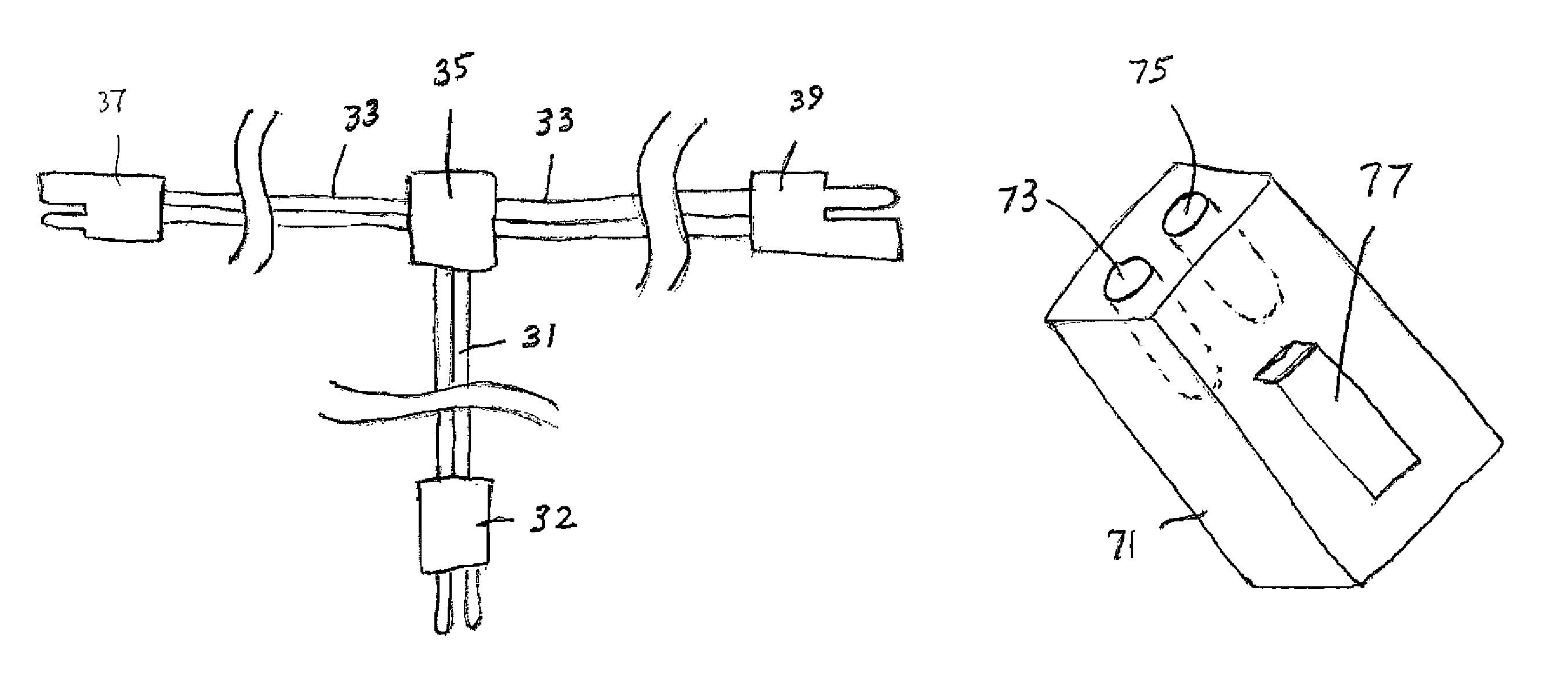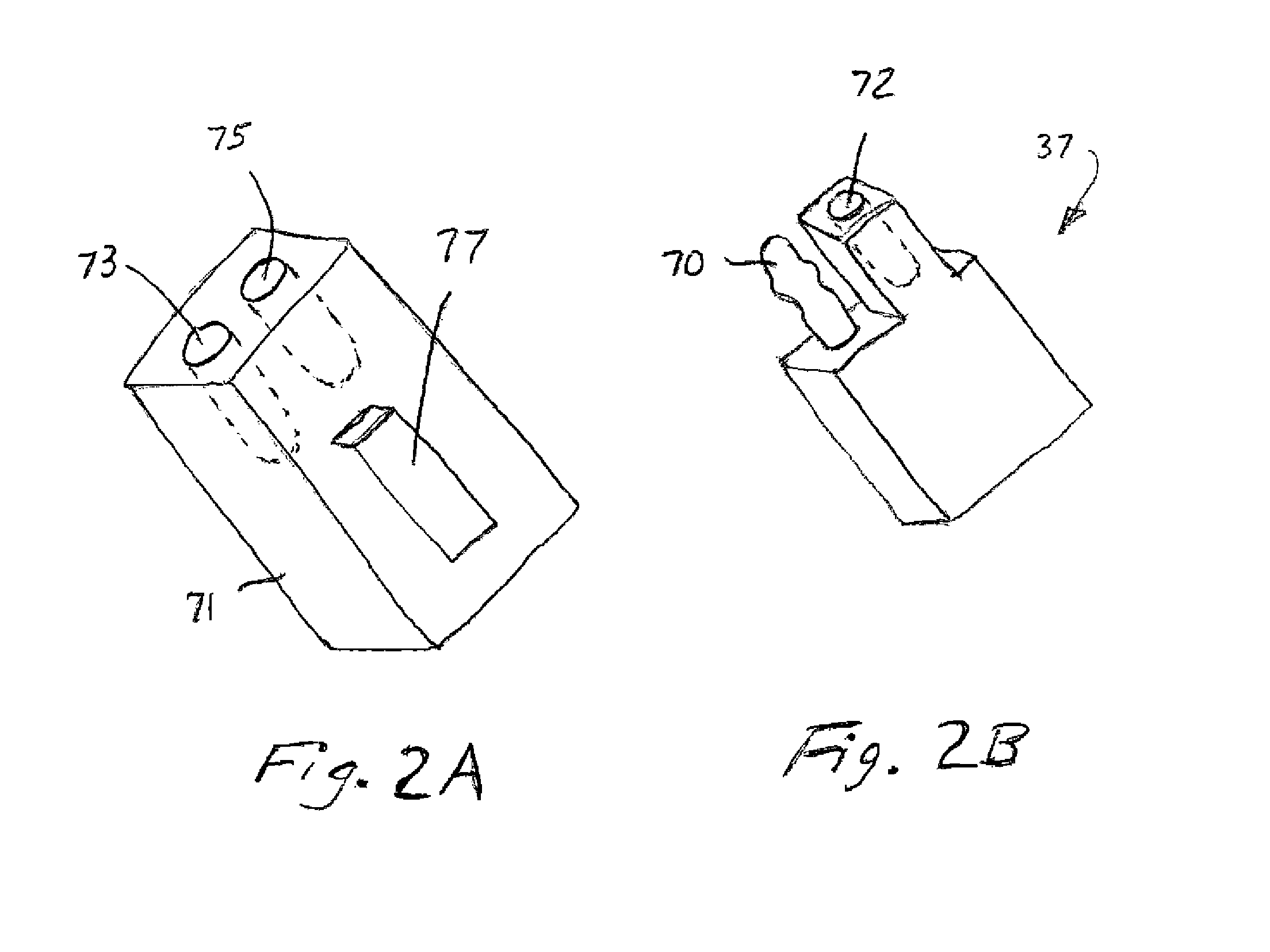Wiring harness having interchangeable connectors
a technology of wiring harnesses and connectors, applied in the field of wiring harnesses, can solve the problems of not being waterproof, not even water-resistant, and laborious, and achieve the effect of convenient hooking
- Summary
- Abstract
- Description
- Claims
- Application Information
AI Technical Summary
Benefits of technology
Problems solved by technology
Method used
Image
Examples
example 1
[0046]This example demonstrates the procedure for lighting a deck via placement of lights on the vertical posts that support the railings of a deck. Except for the wire staples, FIG. 3 shows the collection of components in this embodiment of the deck lighting apparatus.
[0047]A list of components for this installation is as follows:[0048]Light assembly unit with LED light and four color-matched screws[0049]One 60-inch wire lead 42 with connector 44 to plug into LED light assembly[0050]“T” harness featuring two 5-foot leads 41, 43 and three attached plugs 45, 47, 49[0051]Five wire staples for mounting wire harness under the deck[0052]Power supply with integrated AC plug 46, or with 96-inch AC power cord[0053]Light sensor 48 with 30-96 inch electrical lead 51 and wall mounting bracket 52[0054]30-foot power cable 53[0055]Weather resistant cap 55 for terminating end of wiring harness
[0056]To begin the installation, the installer first measures the distance to be sure that the first post ...
example 2
[0068]This example demonstrates the illumination of a set of outdoor stairs associated with a deck. This example also demonstrates other important aspects of the invention such as supplying the wiring for the light units from behind the riser of the steps.
[0069]A list of components for this installation is as follows:[0070]For each step, a Light assembly unit with LED light and two screws[0071]For each step, a “T” harness featuring one 30-inch long lead, and two 9-inch long leads each extending from one end of the 30-inch lead, and three attached plugs[0072]Five wire staples for mounting wire harness behind staircase[0073]Weather-resistant cap[0074]Power supply[0075]Light sensor with electrical lead and wall mounting bracket[0076]6-foot power cable
[0077]To begin the installation, the installer first determines the location of the power outlet. The lead to the first stair light must be available to plug to the power supply lead plug or to a wiring harness that links the stair lights ...
example 3
[0086]This example demonstrates one approach for retrofitting a wooden deck with a low voltage lighting system. The deck includes vertical posts measuring about 3 to 4 feet tall, and a horizontal hand railing between and connecting adjacent posts.
[0087]A wiring harness similar to that described in Example 1 is used in this retrofit. Notable differences include the fact that the electrical lead from the harness to the post light does not need to be as long. Also, and particularly if the vertical posts are separated by more than about 8 feet, a standard length harness may not be long enough, thus necessitating a custom-made harness. This retrofit will consist essentially of placing the wiring harness between the layers or upper and lower portions of the hand rail.
[0088]The hand rail for a deck has an upper and a lower portion or section, fastened together. The upper portion is sometimes being referred to as a hand rail “cap”. The retrofit begins by the deck lighting installer removing...
PUM
| Property | Measurement | Unit |
|---|---|---|
| length | aaaaa | aaaaa |
| length | aaaaa | aaaaa |
| length | aaaaa | aaaaa |
Abstract
Description
Claims
Application Information
 Login to View More
Login to View More - R&D
- Intellectual Property
- Life Sciences
- Materials
- Tech Scout
- Unparalleled Data Quality
- Higher Quality Content
- 60% Fewer Hallucinations
Browse by: Latest US Patents, China's latest patents, Technical Efficacy Thesaurus, Application Domain, Technology Topic, Popular Technical Reports.
© 2025 PatSnap. All rights reserved.Legal|Privacy policy|Modern Slavery Act Transparency Statement|Sitemap|About US| Contact US: help@patsnap.com



